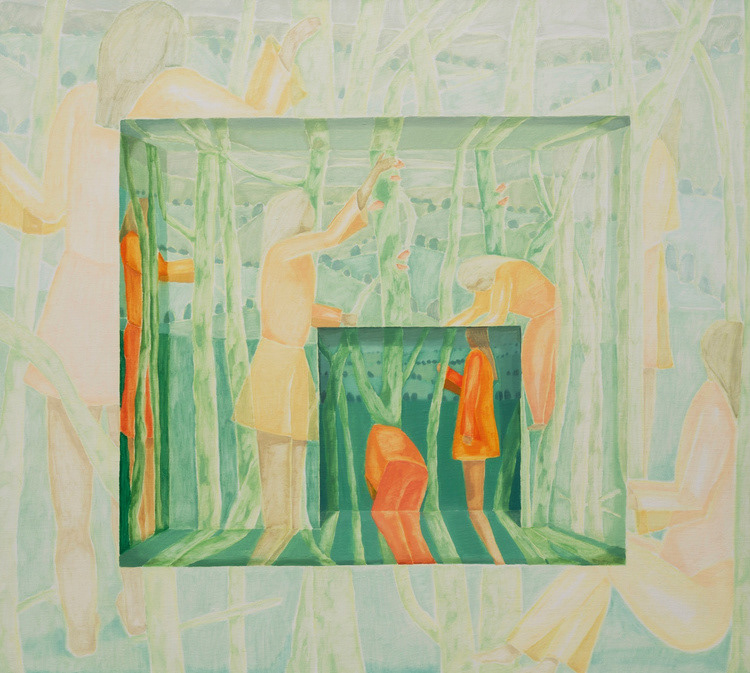Anne Carney Raines, American painter based in London, uses certain techniques to play with our understanding of landscapes. These are characterised in particular by the juxtaposition, within the same composition, of a realistic landscape - often relayed in the background and delineated in a restricted space - with a geometric decor. The latter, made up of a tangle of panels, structures and breaks up the direct apprehension of the landscape by using trompe l’oeil. In this way, the artist creates tension and confusion between the realistic and the fictitious. The decor takes on a theatrical dimension, becoming a parade to question what is realistic and what is not in painting.
Graduating in 2014 with a BA in Painting from Indiana University Bloomington in the United States, the artist began by working as a scenic set painter for a manufacturing studio in Nashville. This set- building experience left a lasting impression on her personal artistic work. In 2019 Anne Carney Raines decided to move to England to study for a Master’s degree in painting at the Royal College of Art in London, graduating in 2021.
Graduating in 2014 with a BA in Painting from Indiana University Bloomington in the United States, the artist began by working as a scenic set painter for a manufacturing studio in Nashville. This set- building experience left a lasting impression on her personal artistic work. In 2019 Anne Carney Raines decided to move to England to study for a Master’s degree in painting at the Royal College of Art in London, graduating in 2021.
Anne Carney Raines' work will soon be featured in the group exhibition "Window": this will be the first time her work has been shown in Paris.
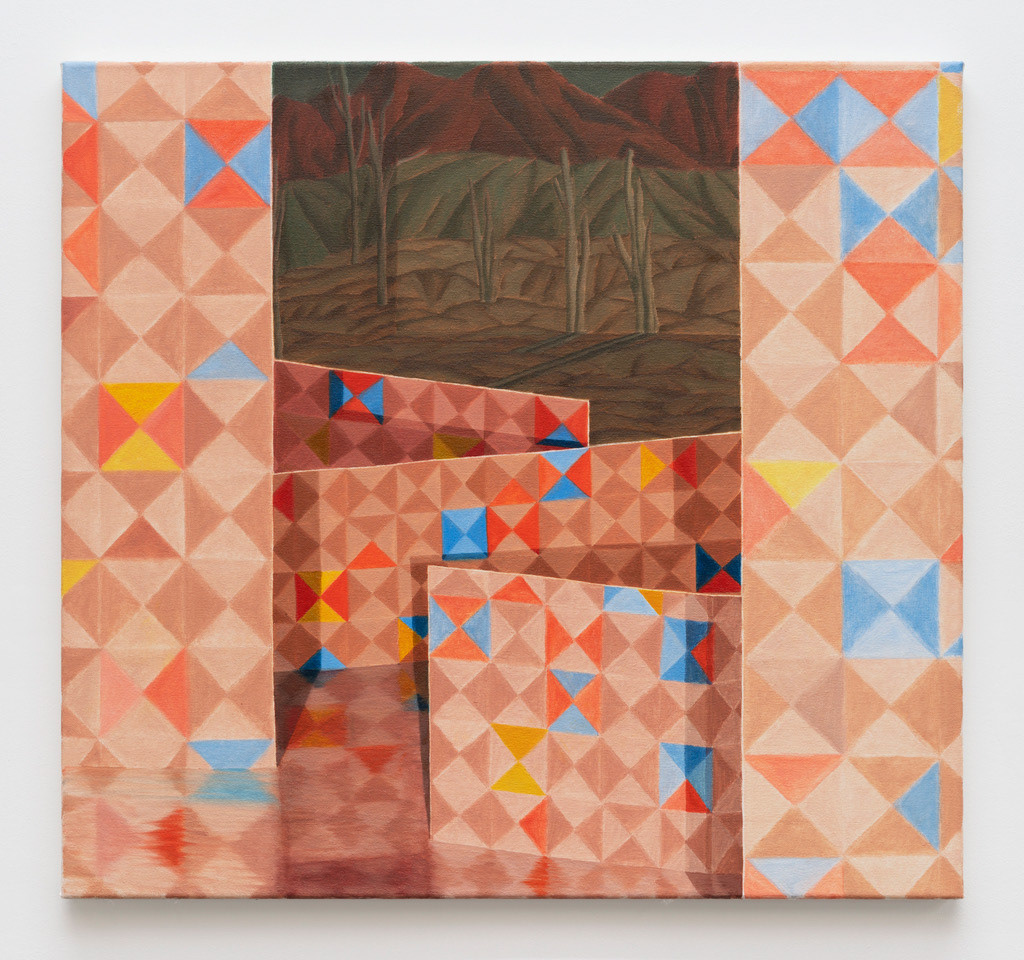
Batting, oil on canvas, 65 x 70 cm, 2023
" I make sure not to look at photographs but to let my memory of these places jumble together to create a strange and false landscape that draws on collective memory. "
Anne Carney Raines
Could you introduce yourself ?
I’m from Nashville, TN (USA) and moved to London in 2019 to get my MA in painting at the Royal College of Art. I’ve been painting since I was young under the guidance of my very creative mother (Photographer, painter, potter, urban flower farmer, and florist). I received my BFA in painting with an Art History minor from Indiana University, Bloomington in 2014 and spent the following five years farming, dog walking, working at a fabrication studio, and making my own work mostly from my home closet-turned-studio. In 2019, I finally felt like I had a body of work that was worth applying to graduate school with.
Your work has the particularity of modulating the pictorial space into entangled spaces opening onto a natural landscape in the background. The panels and curtains, with their decorative or geometric motifs, are reminiscent of those used in theatre sets and, more specifically, trompe l'oeil sets. What is it about these illusionistic spaces that interests you in your work? And how did you come up with this idea?
The seeds of ideas for the work I make now came from my job as a scenic painter at a fabrication studio in Nashville. We were building sets for Comicon, escape rooms, commercials etc. and I became fascinated by faux painting and creating these half realistic spaces inside larger spaces. My interest in trompe l'oeil really boils down to an obsession with shadow and color and my affinity for the lies and tricks of painting.
There's a certain dualism in your compositions: between fictional and realistic spaces, indoor and outdoor spaces. There's an emphasis on trompe l'oeil space, while the realistic landscape is more often relegated to a smaller, background space. Can you tell us a little about this approach and organisation?
I began in 2018 by painting from dioramas made from cardboard. I would create rooms behind rooms behind rooms. When I learned enough about the spaces I wanted to paint and how to paint them I was able to ditch the diorama and paint straight from my head. This organization of space allows me to make paintings within paintings or a series of murals within a fictional environment. I really enjoy blending the exterior with the interior which I think creates a stronger sense of artificiality and the uncanny.
Sometimes, certain compositions only represent a natural landscape. It's the modulation of the space into different planes that extends and shifts the landscape over several sections. I'm thinking of Noon 2, One Thirty, Six Thirty. It shifts its realistic aspect. Is this a way of maintaining a fictional dimension to these more realistic landscapes ?
I use the stage like planes partly to make it clear the landscapes are still in an interior environment. The fiction of the environment and the landscape are really important to me. When I draw or paint a landscape I take from art history as well as landscapes I’ve visited, lived in, hiked, farmed, and loved. I make sure not to look at photographs but to let my memory of these places jumble together to create a strange and false landscape that draws on collective memory.
Colour also plays a part in delimiting these different spaces and temporalities. What do you want to emphasise in this way?
I get really excited by color as most painters do. I try and change up my palette often by restricting myself to different limited color palettes within a body of work. Color can be used within the paintings to differentiate the walls from each other and to emphasize the fiction of the space. If it is a set or an interior or even an underground bunker, there may be different “people” painting different rooms and walls within the fictional environment if that makes sense…
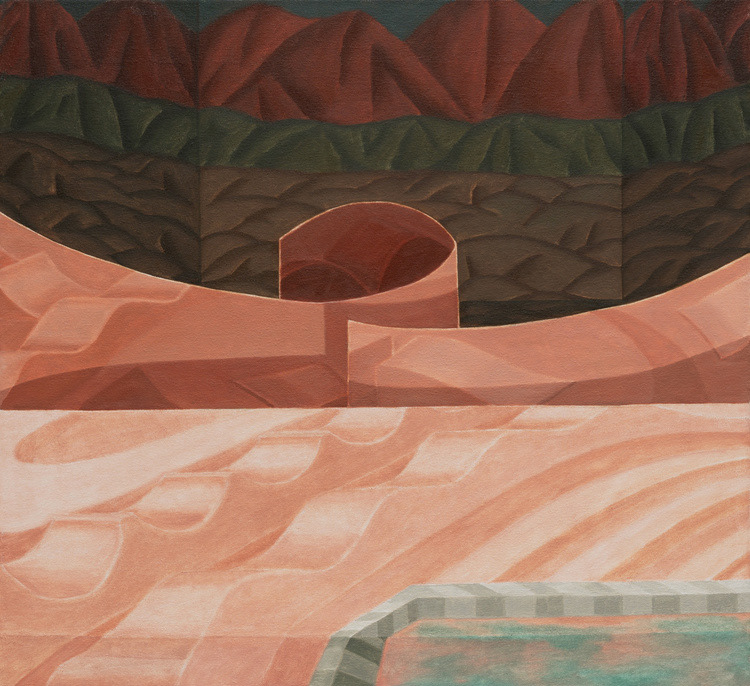
Full Cab, oil on canvas, 65 x 70 cm, 2023
Most of these spaces are uninhabited. Why did you make this choice?
The figure is so powerful and once introduced, it inherently introduces emotion and more specific narrative. I’m more interested in creating an artificial environment or a “stage”. I’m drawn to frescos, wallpaper, ruins, and what these spaces say about the people who occupied them and created them. Uninhabited spaces leave a lot of room for imagination and placing ourselves within new contexts, which can be transformative.
Landscape is therefore central to your work: does it evoke landscapes you have observed? Does your work reflect your personal experiences?
The landscapes reflect memories of places I been and images I’ve seen through painting and even film. Living in a big city I have to rely heavily on my memory which is inherently false and lends itself to Fictioning. Part of painting the landscape is yearning to be living somewhere else.
Can you describe your usual artistic process? Or how your work sessions go? Do you work on several paintings at once?
I make a lot of colored pencil drawings and usually paint from those. The drawings allow me to easily and more quickly get ideas out and enjoy the process of painting. I mostly work on one painting at a time, sometimes two. I get really consumed with a painting and have a hard time focusing on other work until it’s resolved.
What are your main artistic references and influences?
I look at a lot of the Sienese painters like Duccio, Lorenzetti, and Giovanni di Paolo. A lot of museums have been digitizing their manuscripts, so I’ve been looking at imagery from medieval manuscripts like the Holkham Bible Picture Book. I’m influenced by Fellini films like Satyricon and Casanova and TV shows like Star Trek (the Original series and TNG). Some contemporary artists (to name just a few) I look at and love are Matthias Weischer, Claudia Martínez Garay, Anne Hardy, Emma Webster, and Mamma Andersson.
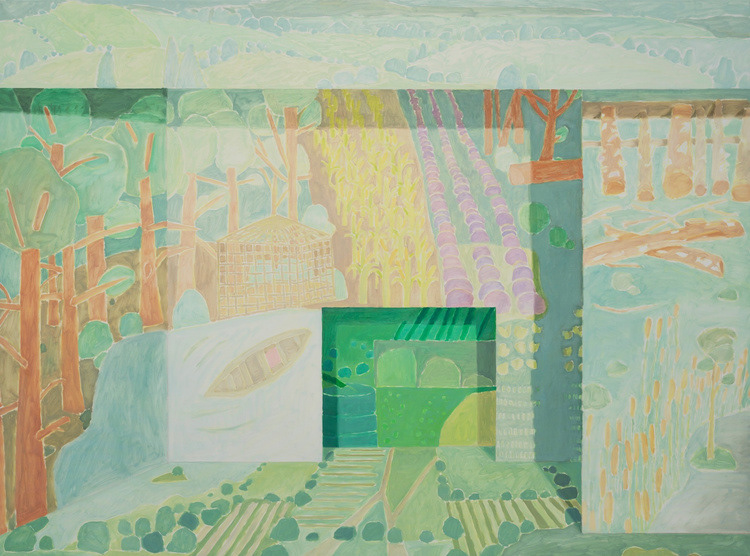
Noon 2, oil on canvas, 100 x 135 cm, 2021
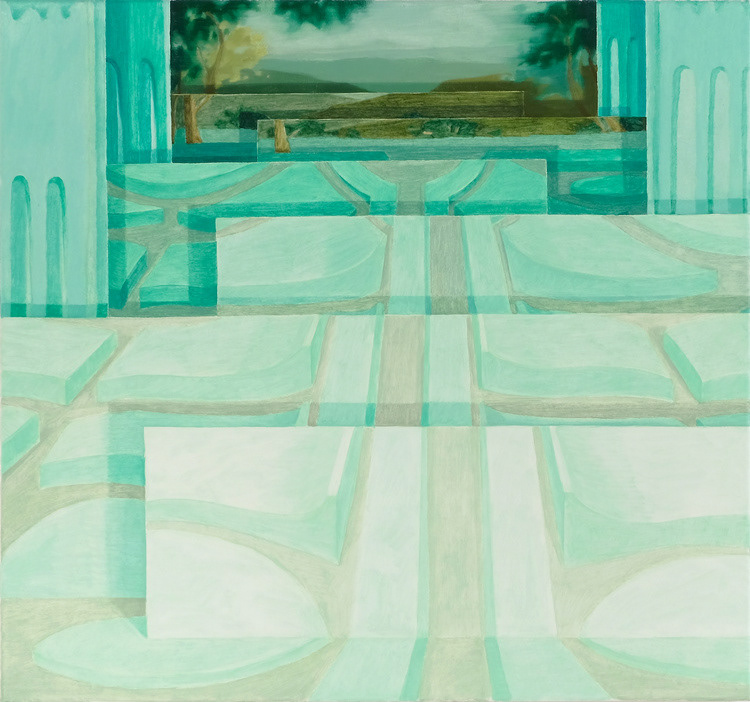
Klonie Garden 1, oil on canvas, 70 x 75 cm, 2021
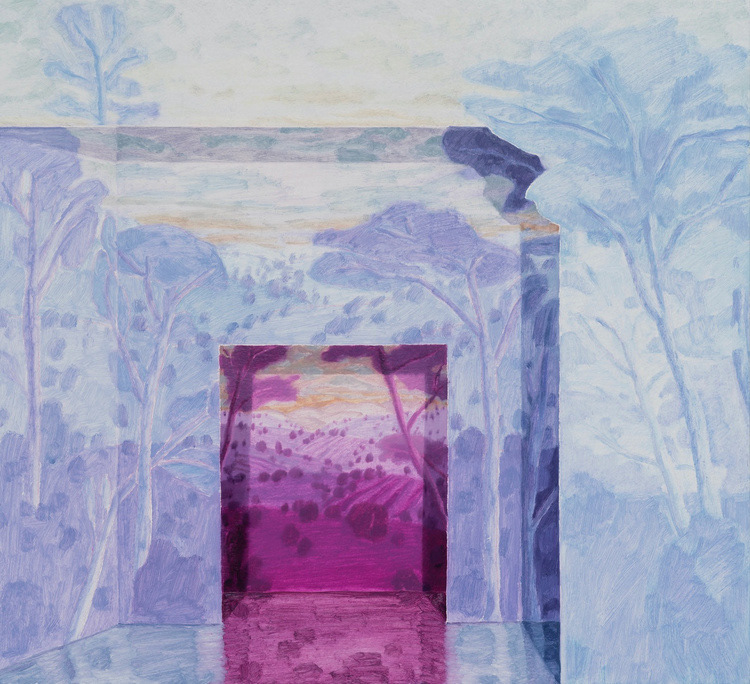
Evening Pickers III, oil on panel, 42.5 x 47 cm, 2021
